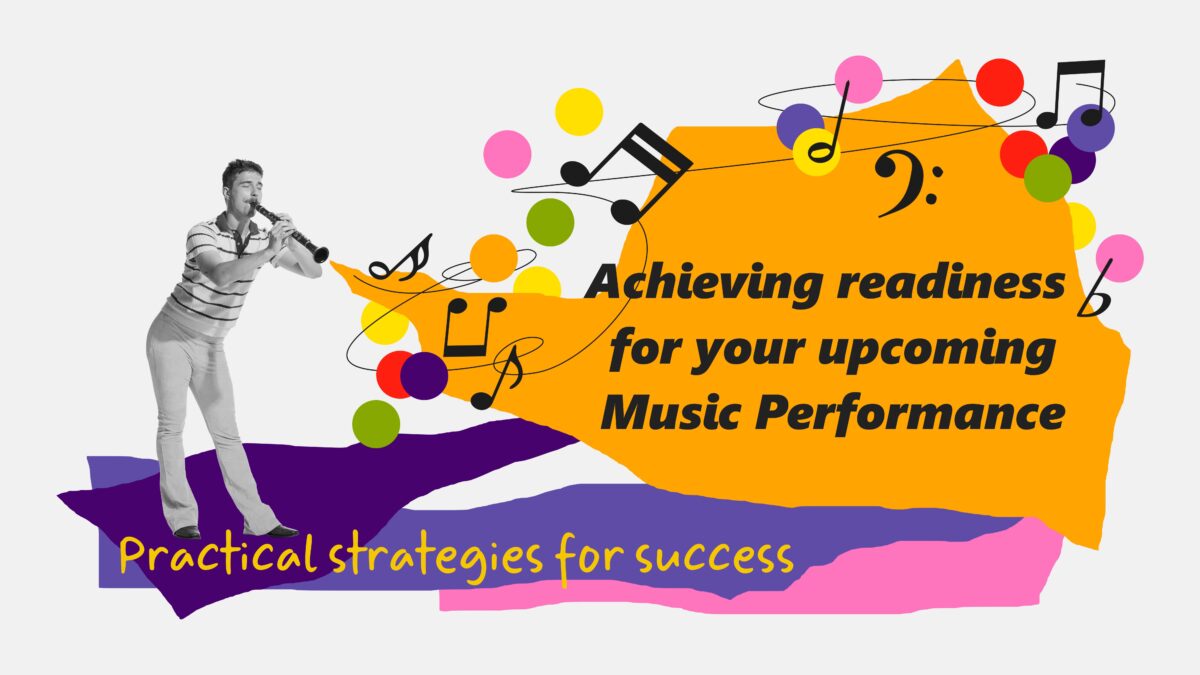How to set yourself for Performance success!

Achieving performance success in your practical exam depends on hours of practice, the mindset you bring, and your ability to communicate your musical expression. Preparing for your practical music examination on a reed instrument like clarinet, oboe or bassoon is a technical and artistic challenge! The following strategies provide a detailed approach to performing confidently under exam conditions.
The practical preparations:
By this stage of the year, prior to your exam you will have established a good practice and support regime!
- You have a regular practice schedule, with time spent on your warm-ups, pieces, technique, aural tests, sightreading and musicality.
- You have been attending lessons with your teacher regularly. You’ve received regular feedback and advice on aspects of your playing and musicality.
- You have had sessions with your accompanist or the ensemble you are performing with. And you have further sessions scheduled leading up to performance day.
- You have been using tools to assist you master the components of your repertoire. This has included metronome practice and use of a tuner or piano to help refine your pitching. You have hopefully been recording your practice sessions to learn as much as you can about your sound production. You’ve been using practice sight-reading material to ensure you are ready for sight reading tests. And you’ve been undertaking aural testing through an app or via the help of a teacher or colleague.
All these achivements will help to ensure your success on performance day! However, if you haven’t established a good practice regime yet, seize this moment to make the most of your remaining time!
Preparing your instrument for exam day
It is important to ensure your instrument is ready for the important performance! Your success is closely related to the condition of your instrument, so it is worth investing in instrument care.
If you hear noise in the key-work, grab some key oil and gently dap a drop against the connections. Key clatter can make it sound like your instrument has its own percussion section! If you have noisy keys, now is the time to get a tweak or a tighten done to soothe your instrument’s mechanisms or replace loose corks or pads. Many instrument repairers or teachers, can look over your instrument quickly and make tweaks to ensure your instrument is ready.
Give your instrument a polish and grease the cork on its joints. Polishing your instrument helps to reduce dust and debris from getting into your pads and tone holes. Greased joints allow everything to operate smoothly on the day. And your instrument will sparkle just like your playing!
It’s a great idea to press some Cleaning Paper against each of your instrument’s pads. The cleaning paper will soak any water and clean debris from the pad surface. This helps keep your pads at optimum playing condition. It also reduces the likelihood of the keys getting sticky and not releasing quickly after you have taken your finger from the keys. The regular use of Cleaning Paper will increase the lifespan of your pads
If you have sticky pads then Powder Paper will reduce the problem. Like the Cleaning Paper, it is used to gently press against the pads that are sticking. Regular use of Powder Paper will ensure your keywork performs quickly and is as responsive as you!
You’ll also need tone-hole cleaners to gently clean the open tone holes of your instrument. Cleaning the tone holes will remove collected debris. This will ensure that no water is able to collect in your tone holes causing the dreaded water-gurgles!
For bassoon players particularly, ensure you have given your bocal a good clean with a specialist bocal brush or Bassoon Bocal Cleaning Swab – Sweet Reeds, and clean the tiny hole in the nipple. Often, this small task immediately makes the instrument easier to play and more free-blowing!
Take some tools with you on the day
It’s a good idea to take a ‘tool kit” with you on the day of your exam performance. The most important items to have are powder paper, cleaning paper, a spring hook tool, and some basic small screwdrivers. Even if you are unsure how to use these items you will find someone who can help at your exam venue. Occasionally, even on well maintained instruments, a screw or spring comes loose and needs a quick tighten or reset. Having some basic tools allows you to be prepared for every circumstance. The added bonus of being prepared will reduce nerves if something unexpected happens on performance day.
By this stage of your preparation you will know whether you will sit or stand to perform. Ensure that you have a good comfortable harness, neck strap, seat strap, spike or thumb rest / thumb cushion (where relevant) which will allow you to play freely. For bassoon, try standing up with the fixture of a balance hanger and without one to see which works best for you. If you are unsure what a balance hanger is, or how to use one, your teacher and /or instrument repair technician will be able to assist you.
Preparing and caring for your reeds for exam day
Reeds are essential for your exam success and are an important part of your preparation.
A poorly functioning reed can sabotage even the best preparation. Or worse, your best reed becomes incapacitated by overuse or breakage, just when you need it most.
To ensure your success on exam day, make sure you have 2-3 reeds available that are equally capable of delivering a wonderful performance. Select these reeds from the reeds you have available to you. And ensure you have a number of new reeds that are ready to be worn-in and perfected for your performance day. It’s important that you have tried each of your ‘performance’ reeds in your practice performances.
It’s important to keep your selected reeds in top shape prior to your exam. Reserve these reeds to use only for your performance. Keep them in a reed case that holds them securely and allows air to circulate around them when not in use. A humidity-controlled reed case can be helpful especially if the weather is changeable.
You’ll also need a reed soaking container. The one shown in this link clips to your music stand, which is handy to have on exam day. Having a soaking cup available ensures that if environmental changes begin to effect your reed, you can give it a quick dip in water between musical items. Often this simple reed-hack will help get the best out of a reed in a performing moment.
Cleaning your reeds prior to your performance is also recommended. A clean can reduce small debris particles that might be stuck inside, underneath and on the surface of your reed. Debris will clog the pores in your reed and restrict its ability to vibrate. Taking your soaked reed, very gently pass a pipe cleaner through the inside of the reed (for double reed players) and gently wash the surface of the reed. If you are unsure about this, you can ask your teacher to help you!
What to take with you on Exam or Performance Day
For double reed players it’s a good idea to have some basic reed adjusting tools handy on performance day. The most important items to carry, include:
- a pair of reed adjusting pliers to open or close the tip of your reed, as environmental conditions can cause the telemetry of your reed to change on the day.
- a mandrel, plaque and some sandpaper or a reed file handy, just in case you need to take a tiny bit of cane from the reed for ease of playing. This is because your performance will sap your energy more than a normal practice or lesson. Your embouchure may become very tired during your performance and having a slightly lighter reed will increase your stamina.
Your success is closely tied to the condition of your reeds, therefore they are as important as your work on repertoire and technical prowess. The simple strategies outlined above will help to ensure you have every chance for success!
Remember: Well-maintained reeds and instruments help you focus entirely on music-making, rather than mechanical distractions!
Other practical exam day preparations
The other practical elements of your exam day performance include:
Know where you are going for your performance and the schedule for the soundcheck and performance.
Understand what will be expected of you, and what order you’ll play your works. Know the musical knowledge, auditory and sight reading test requirements
Have a good sleep the night before your exam and be mentally prepared. Be prepared for the physical symptoms that accompany you personally before and during a performance and feel confident in the strategies you have rehearsed to mitigate the negative effects of these symptoms.
To read about the mental preparation for performance day click this button
Know what you will wear to your exam and ensure that it allows you freedom of movement. For example: Bassoon players are at risk of getting keys caught in items of clothing, so it’s worth practicing in your performance clothes to select the right outfit.
Fill out the relevant documentation to support your performance for the examiner.
Have the music and copies of the music available (providing originals where required).
Ensure if you are using technology, like ipads, foot controllers etc, that your items are charged and bluetooth or wired connections are secure. Bring paper / non technology back-up systems just in case. Ensure that any awkward page turns have been minimised through the use of photocopies or electronic methods.
Prepare for questions the examiner or adjudicator my ask about the music
Know what time you’ll meet your accompanist or ensemble for your pre-exam warm-up and soundcheck prior to the exam. And have a plan for how you will spend your warm up time. Ensure that trying your reeds and playing your instrument across the whole range is part of your warm up to enable you to make sure everything is in good working order! And don’t worry if you notice a problem with your instrument during your warm up. You have your toolkit of supplies ready for this occasion to facilitate an easy fix!
Conclusion
Preparing for a practical music exam is a multifaceted process that combines disciplined practice, technical precision, and expressive artistry. By establishing a structured routine, refining technical skills, nurturing musical interpretation, and preparing mentally for performance, you can approach your exam with confidence and poise. Remember that every minute spent practicing with intention brings you closer to mastering not just your instrument, but the art of musical communication itself.
Would you like to read more about exam preparation: please read our corresponding article preparing for your mind for exam success!
Further Resources:
Gebrian, Molly. Learn Faster, Perform Better. A Musician’s guide to the neuroscience of Practicing. Publisher: G&D Media. 2025
Kish, David. Practicing with Purpose. An Indispensable Resource to Increase Musical Proficiency. Publisher: Meredith Music. 2017
Laduke, Lance. Music Practice Coach. Publisher: Bookbaby, 2001
